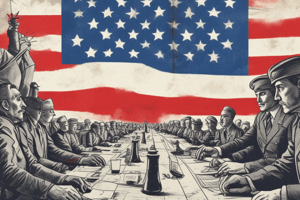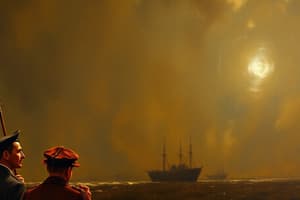Podcast
Questions and Answers
The clash between the U.S. and the USSR after WWII stemmed from their differing ideologies: the U.S. advocated for ______ and democracy, while the USSR promoted communism and totalitarianism.
The clash between the U.S. and the USSR after WWII stemmed from their differing ideologies: the U.S. advocated for ______ and democracy, while the USSR promoted communism and totalitarianism.
capitalism
The ______, initiated in 1947, committed the U.S. to supporting countries resisting communism, marking the beginning of the containment policy.
The ______, initiated in 1947, committed the U.S. to supporting countries resisting communism, marking the beginning of the containment policy.
Truman Doctrine
The ______ was a U.S. initiative that provided substantial financial aid to Western Europe to rebuild their economies and prevent communist takeovers.
The ______ was a U.S. initiative that provided substantial financial aid to Western Europe to rebuild their economies and prevent communist takeovers.
Marshall Plan
Stalin's blockade of West Berlin led to the ______, where the U.S. and Britain supplied the city with food and supplies via air for nearly a year.
Stalin's blockade of West Berlin led to the ______, where the U.S. and Britain supplied the city with food and supplies via air for nearly a year.
[Blank] was the first peacetime military alliance for the U.S., forming a mutual defense pact with Canada and Western Europe in 1949.
[Blank] was the first peacetime military alliance for the U.S., forming a mutual defense pact with Canada and Western Europe in 1949.
[Blank] was a secret policy document that advocated for a massive military buildup, perceiving the Cold War as a long-term global ideological conflict.
[Blank] was a secret policy document that advocated for a massive military buildup, perceiving the Cold War as a long-term global ideological conflict.
The Second ______ in the U.S. was characterized by intense fear of communist infiltration, leading to investigations by HUAC and accusations against figures like Alger Hiss and the Rosenbergs.
The Second ______ in the U.S. was characterized by intense fear of communist infiltration, leading to investigations by HUAC and accusations against figures like Alger Hiss and the Rosenbergs.
Senator Joseph ______ gained notoriety for claiming hundreds of communists were in the U.S. government, though he never provided solid evidence.
Senator Joseph ______ gained notoriety for claiming hundreds of communists were in the U.S. government, though he never provided solid evidence.
Executive Order ______, issued by President Truman in 1948, desegregated the armed forces.
Executive Order ______, issued by President Truman in 1948, desegregated the armed forces.
The ______ War (1950–1953) began when North Korea invaded South Korea and ended in a stalemate at the 38th parallel.
The ______ War (1950–1953) began when North Korea invaded South Korea and ended in a stalemate at the 38th parallel.
Eisenhower advocated ______ Republicanism, which aimed to be conservative on monetary policy but liberal on human rights.
Eisenhower advocated ______ Republicanism, which aimed to be conservative on monetary policy but liberal on human rights.
[Blank], a foreign policy strategy under Eisenhower, involved pushing adversaries to the brink of war to force concessions.
[Blank], a foreign policy strategy under Eisenhower, involved pushing adversaries to the brink of war to force concessions.
The CIA was involved in the overthrow of Mossadegh in ______ in 1953, reinstating the Shah, and in the coup in Guatemala in 1954, ousting the left-leaning government of Arbenz.
The CIA was involved in the overthrow of Mossadegh in ______ in 1953, reinstating the Shah, and in the coup in Guatemala in 1954, ousting the left-leaning government of Arbenz.
Postwar prosperity saw the rise of ______, exemplified by developments like Levittowns, which also contributed to white flight and urban decline.
Postwar prosperity saw the rise of ______, exemplified by developments like Levittowns, which also contributed to white flight and urban decline.
The ______ Act of 1956 created the interstate system, supporting both car culture and the growth of suburbs.
The ______ Act of 1956 created the interstate system, supporting both car culture and the growth of suburbs.
Betty Friedan’s "The Feminine Mystique" challenged the ideal of the 1950s woman as solely a ______ and mother.
Betty Friedan’s "The Feminine Mystique" challenged the ideal of the 1950s woman as solely a ______ and mother.
The ______ Bus Boycott (1955–1956), sparked by Rosa Parks' arrest, led to Martin Luther King Jr.'s emergence as a civil rights leader.
The ______ Bus Boycott (1955–1956), sparked by Rosa Parks' arrest, led to Martin Luther King Jr.'s emergence as a civil rights leader.
The launch of ______ by the Soviet Union in 1957 triggered fears of a missile gap in the U.S. and led to increased funding for STEM education.
The launch of ______ by the Soviet Union in 1957 triggered fears of a missile gap in the U.S. and led to increased funding for STEM education.
The ______ Incident in 1960, involving a U.S. spy plane shot down over the USSR, worsened Cold War tensions after Eisenhower initially denied the plane's purpose.
The ______ Incident in 1960, involving a U.S. spy plane shot down over the USSR, worsened Cold War tensions after Eisenhower initially denied the plane's purpose.
In response to NATO, the Soviet Union and its satellite states formed the ______ in 1955, solidifying the division of Europe into opposing military alliances.
In response to NATO, the Soviet Union and its satellite states formed the ______ in 1955, solidifying the division of Europe into opposing military alliances.
Flashcards
Containment Policy
Containment Policy
A policy to prevent the spread of communism, without necessarily rolling it back where it already existed.
Marshall Plan
Marshall Plan
A U.S. plan that provided significant economic assistance to rebuild Western Europe after World War II, aiming to strengthen capitalist democracies.
NATO
NATO
A military alliance formed in 1949 among the U.S., Canada, and Western European countries to provide mutual defense against Soviet aggression.
NSC-68
NSC-68
Signup and view all the flashcards
Second Red Scare
Second Red Scare
Signup and view all the flashcards
McCarthyism
McCarthyism
Signup and view all the flashcards
Executive Order 9981
Executive Order 9981
Signup and view all the flashcards
Korean War
Korean War
Signup and view all the flashcards
Modern Republicanism
Modern Republicanism
Signup and view all the flashcards
Brinkmanship
Brinkmanship
Signup and view all the flashcards
Massive Retaliation
Massive Retaliation
Signup and view all the flashcards
Suburbanization
Suburbanization
Signup and view all the flashcards
The Feminine Mystique
The Feminine Mystique
Signup and view all the flashcards
Brown v. Board of Education
Brown v. Board of Education
Signup and view all the flashcards
Montgomery Bus Boycott
Montgomery Bus Boycott
Signup and view all the flashcards
Little Rock Nine
Little Rock Nine
Signup and view all the flashcards
Sputnik
Sputnik
Signup and view all the flashcards
U-2 Incident
U-2 Incident
Signup and view all the flashcards
Truman Doctrine
Truman Doctrine
Signup and view all the flashcards
Warsaw Pact
Warsaw Pact
Signup and view all the flashcards
Study Notes
Foundations of the Cold War
- Post-World War II, the U.S. and USSR emerged as superpowers with conflicting ideologies: capitalism/democracy versus communism/totalitarianism.
- The Yalta and Potsdam Conferences revealed disputes over Eastern Europe and postwar arrangements.
Truman Doctrine (1947)
- Prompted by unrest in Greece and Turkey.
- The U.S. pledged support to countries resisting communism.
- Marked the beginning of the containment policy: aimed to prevent the spread of communism.
Marshall Plan (1948)
- Provided $12 billion+ in aid to rebuild Western Europe's economy.
- It was designed to strengthen capitalist democracies and prevent communist takeovers.
- A very successful plan, allowed Western Europe to recover quickly.
Berlin Airlift (1948–1949)
- Stalin blockaded West Berlin to force Allies out.
- The U.S. and Britain responded by airlifting food and supplies for almost a year.
- Resulted in the end of the blockade; NATO was formed shortly after as a military alliance.
Creation of NATO (1949)
- The first peacetime alliance for the U.S.
- A mutual defense pact among the U.S., Canada, and Western Europe.
- The Soviet response was the Warsaw Pact (1955).
NSC-68 (1950)
- A secret policy document that recommended a major military buildup.
- The Cold War was viewed as a global ideological conflict requiring long-term readiness.
The Second Red Scare
- An intense fear of internal communist infiltration in the U.S.
- HUAC (House Un-American Activities Committee) investigated "un-American" behavior, especially in Hollywood.
- Alger Hiss was accused of being a Soviet spy and convicted of perjury.
- The Rosenbergs were executed for allegedly passing atomic secrets to the USSR.
Senator Joseph McCarthy
- Claimed hundreds of communists were in the U.S. government, but offered no solid evidence.
- "McCarthyism" became synonymous with reckless accusations and fearmongering.
- He was eventually discredited in televised hearings (Army-McCarthy hearings).
Civil Rights under Truman
- Executive Order 9981 (1948) desegregated the armed forces.
- Marked the start of federal involvement in civil rights.
Korean War (1950–1953)
- North Korea (backed by USSR/China) invaded South Korea (backed by the U.S./UN).
- Initial U.S. gains were reversed after Chinese intervention.
- Ended in stalemate with a ceasefire at the 38th parallel.
- Expanded the Cold War to Asia, the first armed conflict of the Cold War.
Eisenhower’s Presidency (1953–1961)
- He advocated Modern Republicanism: conservative on money, liberal on human rights.
- Balanced the budget and supported some New Deal programs.
Foreign Policy under Eisenhower
- Practiced Brinkmanship: pushing adversaries to the brink of war to force concessions.
- Operated under Massive Retaliation: the U.S. would respond with nuclear force if attacked.
- The CIA was involved in Iran (1953): Overthrew Mossadegh, reinstated the Shah.
- The CIA was involved in Guatemala (1954): Overthrew the left-leaning government of Arbenz.
Postwar Economic Boom
- GNP doubled, unemployment was low, and there was widespread prosperity.
- Consumer culture exploded: TVs, appliances, cars, advertising.
- The GI Bill helped veterans access college education and home loans.
Suburbanization
- Levittowns: Mass-produced suburban housing developments.
- Expansion of the middle class also fueled white flight and urban decline.
- The Highway Act of 1956 created the interstate system, supporting car culture and suburbs.
Gender Roles and Family Life
- The ideal of the 1950s woman as a homemaker/mother was reinforced by media.
- Betty Friedan’s The Feminine Mystique (early 1960s) later challenged this ideal.
Youth Culture & Dissent
- Rise of rock and roll (Elvis Presley), beatniks, and youth rebellion.
- Teens became a distinct cultural and economic force.
Civil Rights Movement Begins
- Brown v. Board of Education (1954) overturned "separate but equal".
- This sparked resistance in the South and momentum for activism.
- Montgomery Bus Boycott (1955–1956): Rosa Parks’ arrest led to a 381-day boycott; MLK emerged as a leader.
- Little Rock Nine (1957): Federal troops enforced desegregation at Central High in Arkansas.
Cold War Intensifies
- Sputnik (1957): The Soviet satellite launch shocked the U.S. and triggered fears of a missile gap.
- Led to the creation of NASA and a focus on STEM education.
- U-2 Incident (1960): A U.S. spy plane was shot down over the USSR; Eisenhower denied it at first, worsening tensions.
Timeline Events
- 1945: End of World War II, Yalta and Potsdam Conferences, United Nations established.
- 1947: Truman Doctrine, Marshall Plan proposed, Loyalty Review Board created.
- 1948: Berlin Blockade/Airlift, Executive Order 9981, Truman re-elected.
- 1949: NATO formed, the Soviet Union tested its first atomic bomb, China became communist.
- 1950: NSC-68 issued, Korean War began.
- 1953: Korean War armistice, Eisenhower became president, CIA overthrew Iranian Prime Minister Mossadegh.
- 1954: Brown v. Board of Education, the CIA orchestrated a coup in Guatemala.
- 1955: Montgomery Bus Boycott began, Warsaw Pact formed, Emmett Till murdered.
- 1956: Federal Highway Act passed, Southern Manifesto issued.
- 1957: Little Rock Nine integrated Central High School, USSR launched Sputnik, Civil Rights Act of 1957.
- 1960: U-2 Incident, JFK elected president.
- 1961: Bay of Pigs Invasion, Berlin Wall constructed, Freedom Rides began.
- 1962: Cuban Missile Crisis.
- 1963: March on Washington, Birmingham Campaign, JFK assassinated, LBJ became president.
- 1964: Civil Rights Act of 1964, Freedom Summer, Gulf of Tonkin Resolution.
- 1965: Voting Rights Act of 1965, Selma to Montgomery Marches, Watts Riot, U.S. began large-scale troop deployment to Vietnam.
- 1966: Black Panther Party formation, National Organization for Women (NOW) founded.
- 1967: Summer of Love, race riots in Detroit and Newark, anti-Vietnam War protests increased.
- 1968: Tet Offensive, MLK assassinated, RFK assassinated, Democratic National Convention protests, Richard Nixon elected president.
Studying That Suits You
Use AI to generate personalized quizzes and flashcards to suit your learning preferences.





